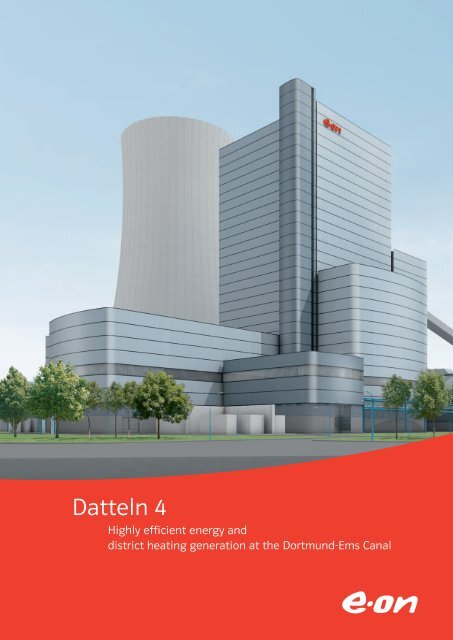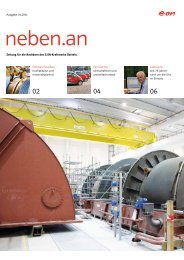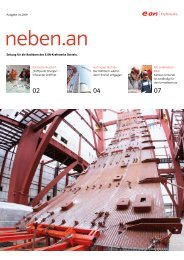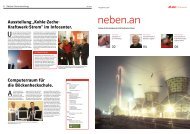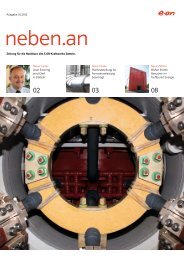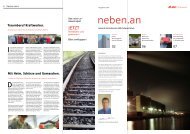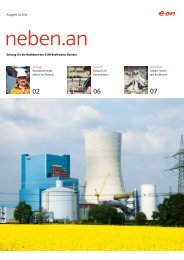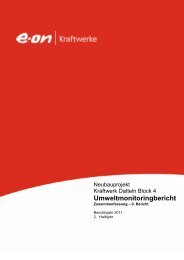Datteln 4 - Kraftwerk Datteln
Datteln 4 - Kraftwerk Datteln
Datteln 4 - Kraftwerk Datteln
You also want an ePaper? Increase the reach of your titles
YUMPU automatically turns print PDFs into web optimized ePapers that Google loves.
<strong>Datteln</strong> 4<br />
Highly effi cient energy and<br />
district heating generation at the Dortmund-Ems Canal
2<br />
<strong>Datteln</strong> 4 will be one of the most effi cient and powerful hard coal-fi red power plants in<br />
the world. This new power plant will go online with around 20 percent less fuel consumption<br />
than the older generation. This secures our energy supply and helps to protect the<br />
environment.<br />
We’re building the future
Why is E.ON building a new hard<br />
coal-fi red power plant?<br />
Why is the power plant so big?<br />
Why in <strong>Datteln</strong>?<br />
How will <strong>Datteln</strong> 4 affect the environment?<br />
3
4<br />
A good mix is necessary<br />
Big means affordable<br />
The right location<br />
Better for the environment
Energy from wind, sun and water power – can’t these cover all our energy needs? Unfortunately, the sun doesn’t shine<br />
every day, and the wind takes days off, too. The potential to generate power using hydroelectric dams has been largely<br />
exhausted in Germany. Hard coal-fi red power plants are still needed alongside other power generation methods in<br />
order to guarantee an affordable and secure supply. This is why E.ON is focusing on a balanced energy mix. The new<br />
<strong>Datteln</strong> 4 hard coal-fi red power plant is a part of this strategy.<br />
>> See page 6 for more on this topic<br />
Size provides a cost advantage in power generation. The higher the output of a power plant, the more affordable it is to<br />
operate, allowing us to sell power more cheaply. A high degree of effi ciency can be realized in large power plants. Today,<br />
we are able to generate twice as much electricity from one kilogram of hard coal as we were 50 years ago. This means<br />
lower emissions and a more careful use of resources. For this reason, large power plants will contue to form the backbone<br />
of our power generation capacity in the future.<br />
>> See page 7 for more on this topic<br />
Regions with a high population density – like the Ruhr area – need a lot of energy. However, it is not possible to store<br />
large amounts of electricity. We need to generate it exactly when it is needed. In addition, coal-fi red power plants require<br />
a strong logistics infrastructure, which is present at the <strong>Datteln</strong> location thanks to the present power plant facilities<br />
<strong>Datteln</strong> 1 through 3. These will be replaced by <strong>Datteln</strong> 4 because they have reached the end of their technical and economic<br />
lifetime. This means that this new build project will enable us to retain important jobs in the region for the coming<br />
decades.<br />
>> See page 12 for more on this topic<br />
The new power plant will have a net electrical effi ciency of over 45 percent. The simultaneous extraction of district heat<br />
means that over 60 percent of the potential energy in the fuel can be utilized. <strong>Datteln</strong> 4 will replace not only the existing<br />
power plants in <strong>Datteln</strong>, but another old facility in the Ruhr area as well, and E.ON has already shut down 1,800 MW<br />
of fossil-powered power plant output there. Even though the facility produces signifi cantly more energy than its predecessors,<br />
it will improve the region’s environmental footprint signifi cantly. The key is the improved efficiency and the<br />
decommissioning of the old, less efficient facilities. The new power plant will have a modern, multi-step fl ue gas<br />
purifi cation system. This will remove nitrogen oxides, dust and sulfur from the fl ue gas – and to a greater extent than<br />
what is currently required by law. The state environmental authority verifi es that the emission limit values are adhered<br />
to around the clock, 365 days a year.<br />
>> See page 14 for more on this topic<br />
5
6<br />
What energy mix makes sense?<br />
We need electricity for most of the things we do every day. But can't we meet all our<br />
energy needs using wind, water and solar energy? No, not reliably enough. Therefore<br />
E.ON relies on a balanced energy mix and invests into the development of innovative,<br />
climate-friendly technologies of the future at the same time.<br />
Energy mix 2009<br />
Power generation in Germany in 2009 currently amounts to a total<br />
of 597 billion kWh<br />
oil/gas 13 %<br />
renewables<br />
and others<br />
22 %<br />
42 % coal<br />
23 %<br />
nuclear<br />
energy<br />
It’s all about the mix<br />
All power generation resources have advantages<br />
and disadvantages. When deciding for or against<br />
a particular energy source, security of supply, price<br />
considerations and environmental sustainability<br />
come into equal play. In our view, it would be<br />
foolish to move away from a balanced energy<br />
mix – at least as long as it remains unclear how<br />
to sensibly replace fossil fuels.<br />
In Germany, E.ON generates in 2009<br />
a total of 112 Mrd. kWh<br />
oil/gas<br />
renewables<br />
and others<br />
4 %<br />
11 %<br />
coal 29 %<br />
Hard coal is and will remain an important energy<br />
source<br />
Hard coal will continue to be an important part<br />
of the energy mix in the future. Experts have calculated<br />
that the worldwide supply of coal will be<br />
enough to meet growing energy needs for several<br />
hundred years, even taking into account the continued<br />
growth of populous countries. In addition<br />
many countries in the world have considerable<br />
coal supplies. This allows them to avoid becoming<br />
dependent – as is the case with oil and gas – on<br />
single regions of the world that may be politically<br />
unstable.<br />
Yet the problem of CO 2 emissions from burning<br />
coal remains. This is why E.ON is focusing on<br />
increasing the energy effi ciency of thermal power<br />
plants like <strong>Datteln</strong>. Greater effi ciency always leads<br />
to less CO 2 per generated kilowatt hour (KWh).<br />
56 % nuclear<br />
energy
Effi ciency of hard coal-fi red power plants, worldwide comparison<br />
in % 1)<br />
60<br />
40<br />
20<br />
~ 30 35 36 38 40 > 45<br />
World USA Europe Germany E.ON today<br />
1) Average value for existing and new plants<br />
Less CO2 , higher effi ciency<br />
E.ON has set itself the goal of reducing its specifi c<br />
CO 2 in Europe by 2020 by 50 % compared to 1990<br />
– which is 10 years earlier than planned so far.<br />
The focus lies on the substantial expansion of<br />
renewable energies. Furthermore nuclear energy<br />
as well as highly effi cient hard coal- and gas-fi red<br />
power plants will make important contributions.<br />
And already today these power plants achieve<br />
outstanding degrees of efficiency in global comparison.<br />
<strong>Datteln</strong> 4<br />
starting<br />
in 2012<br />
<strong>Datteln</strong> 4 sets new standards<br />
By optimizing the system technology <strong>Datteln</strong> 4<br />
will be setting new benchmarks in terms of effi -<br />
ciency. The power plant will be able to exhibit an<br />
effi ciency of over 45 %. This represents a substantial<br />
increase over the German average. Extracting<br />
the district heat increases the effi ciency factor<br />
of the fuel used to over 60 %. To compare a Diesel<br />
motor achieves 35 %.<br />
Additionally, <strong>Datteln</strong> 4 will replace both the old<br />
power plant facilities <strong>Datteln</strong> 1 through 3, as well<br />
as other power plants in the Ruhr area. <strong>Datteln</strong> 4,<br />
with its high effi ciency rate and its low specifi c<br />
CO 2 output, will be used more than the older<br />
facilities, because effi ciently generated electricity<br />
is cheaper. This will push plants with lower<br />
effi ciency and higher CO 2 output out of the<br />
generation market. This represents a long-term<br />
victory for the environment.<br />
7
8<br />
<strong>Datteln</strong> 4
8<br />
10<br />
3<br />
2<br />
1<br />
5<br />
6<br />
7<br />
9<br />
4<br />
1<br />
2<br />
3<br />
4<br />
5<br />
6<br />
7<br />
8<br />
9<br />
10<br />
Boiler house<br />
Powerhouse<br />
Cooling tower<br />
Coal storage<br />
Flue gas purifi cation<br />
Outside air switching facility<br />
Flue ash silo<br />
Water supply and disposal<br />
Traction current converter<br />
Administrative building<br />
11
9<br />
How does the <strong>Datteln</strong> hard coal-fired po<br />
Power plant technology is not a mystery. Water, steam and coal are the most important<br />
elements in power generation. It all comes down to their interaction and the processes<br />
they undergo. The facility in <strong>Datteln</strong> 4 is a real powerhouse: compact and a high performer.<br />
Function diagram <strong>Datteln</strong> 4<br />
Technical data <strong>Datteln</strong> 4<br />
Electric output<br />
Water-steam cycle<br />
Cooling water cycle<br />
Flue gases<br />
Electricity for public supply<br />
Traction current<br />
District heat<br />
Net effi ciency (electrical)<br />
Fuel requirement<br />
Steam output<br />
Live steam parameters<br />
Flue gas capture<br />
MW: Megawatts t/h: Tons per hour<br />
air<br />
Flue gas<br />
purifi cation<br />
plant<br />
Supply<br />
1 Coaling station<br />
2 Ammonia (NH3) line<br />
3 Process and operating water<br />
4 Calcium carbonate<br />
Process<br />
5 Coal bunker<br />
6 Coal pulverizer<br />
7 Outside air<br />
8 Steam generator<br />
9 Live steam<br />
Boiler house<br />
1,100 MW gross<br />
1,055 MW net<br />
642 MW (50 Hz)<br />
413 MW (16.7 Hz)<br />
380 MW max.<br />
> 45 %<br />
360 t/h hard coal<br />
2,950 t/h<br />
6oo°C/285 bar<br />
Via a cooling tower<br />
Powerhouse<br />
10 High-pressure turbine<br />
11 Medium-pressure turbine<br />
12 Low-pressure turbines<br />
13 Generator<br />
14 Transformer<br />
15 Condenser<br />
16 Condensate pump<br />
17 Regenerative pre-heating<br />
18 Boiler feed pump<br />
19 De-asher<br />
20 Coarse ashes<br />
21 Feed water<br />
22 NOx removal: catalyst<br />
23 Dust removal: Electric fi lter<br />
24 Sulfur removal: SO2 washer<br />
25 Cooling water purifi cation<br />
26 Cooling water pump<br />
27 Cooling tower<br />
Waste<br />
28 Pulverized fuel ash as a<br />
cement additive<br />
29 Gypsum drainage<br />
30 Gypsum for industrial use
wer plant work?<br />
Coal delivery, boiler and turbine<br />
1 Coal storage<br />
2 Coal bunker<br />
3 Coal pulverizer<br />
4 Addition of outside air<br />
5 Boiler<br />
6 Combustion chamber<br />
The path to the boiler<br />
Barges deliver hard coal via the Dortmund-Ems<br />
Canal. They discharge their cargo in a purposebuilt<br />
E.ON harbor with the help of continual ship<br />
unloaders. Closed conveyor belt facilities transport<br />
the fuels to the coal storage (1) or directly into the<br />
coal bunker (2).<br />
Five coal pulverizers (3) grind the delivered hard<br />
coal to a fi ne dust. The coal dust is fi rst dried using<br />
hot air and then blown into the boiler’s combustion<br />
chamber. The grinding process results in a<br />
far greater coal surface area, leading to optimal<br />
combustion.<br />
Boiler house Powerhouse<br />
7 Pipelines<br />
8 Feed water<br />
9 Turbines<br />
10 Condenser<br />
11 Generator<br />
12 Transformer<br />
From steam to electricity<br />
The boiler house is where you will fi nd the stream<br />
generator itself (5). It consists of the combustion<br />
chamber (6) and a complex system of pipes (7).<br />
In normal operation the fi nely ground coal dust is<br />
burned at over 1,300 de grees Celsius in the combustion<br />
chamber. The resulting heat brings the water<br />
in the lines to a boil. The water is transformed into<br />
steam, which is then passed into the turbines at high<br />
pressure.<br />
The steam turbine (9) turns at 3,000 revolutions<br />
per minute. It consists of one high-pressure, one<br />
medium-pressure, and two low-pressure sections.<br />
There, blades transfer the steam’s energy onto the<br />
shaft. The turbine is linked to a generator (11), which<br />
transforms mechan ical energy into electrical energy<br />
– very simliar to a dynamo. The generated electricity<br />
is supplied into the grid through a transformer (12).
Cooling tower<br />
13 Condenser<br />
14 Dortmund-Ems Canal<br />
15 Cooling water purifi cation<br />
16 Cooling water pump<br />
17 Cooling tower<br />
As an inland location, <strong>Datteln</strong> 4 exhibits a very<br />
high degree of effi ciency. Over 45 percent of the<br />
energy in the coal is converted into electrical<br />
energy – this is high-performance technology.<br />
Water cools the steam<br />
Once the steam has gone through all the turbine<br />
stages, it turns back into water in the condenser<br />
(13) and begins its journey through the boiler<br />
again. This concludes the water-steam cycle. Only<br />
the water that evaporates out of the cool ing<br />
tower is removed from the Dortmund-Ems Canal<br />
(14). After heating in the condenser, the cooling<br />
water ends up in the natural draft cooling tower<br />
(17). This performs two functions: First, the cooling<br />
water transfers its heat to the air stream ing in<br />
from the bottom. Second, the cooling tower captures<br />
the purifi ed fl ue gases. This makes a second<br />
fl ue unnecessary.<br />
The cooling tower’s height of nearly 180 meters<br />
is needed in order to reach the desired plant effi -<br />
ciency of over 45 %. If we used smaller ventilator<br />
cooling towers, the plant effi ciency would diminish<br />
as a function of increased station supply, and<br />
fuel consumption and CO 2 emissions would rise.<br />
This means that an optimal cooling tower height<br />
also contributes to climate protection.
Flue gas purifi cation<br />
18 Ammonia<br />
19 Outside air<br />
20 NO x removal system<br />
21 Electric fi lter<br />
22 Pulverized fuel ash<br />
23 Calcium carbonate<br />
No-risk fl ue gas<br />
Before the fl ue gas enters the atmosphere, it is<br />
painstakingly purifi ed. It is especially important<br />
to remove sulfur dioxide (SO 2), nitrogen oxide<br />
(NO x) and dust. The purifi cation process has three<br />
phases: In the NOx removal system (20), catalysts<br />
convert the nitrogen oxide into the environmentally<br />
neutral substances water and nitrogen by<br />
means of ammonia (18) – air consists of 79 %<br />
nitrogen naturally.<br />
The next step in fl ue gas purifi cation is an electric<br />
fi lter (21) that captures pulverized fuel ash. This<br />
ash is collect ed in an ash bunker and sold to<br />
the construction industry, which uses it e.g. as a<br />
cement additive.<br />
24 Process water<br />
25 Sulfur removal system<br />
26 Gypsum drainage<br />
27 Gypsum<br />
The sulfur removal system (25) washes the fl ue<br />
gas. The sulfur dioxide reacts chemically with<br />
a limestone water mixture and oxygen. Gypsum<br />
and water are left over. The dried gypsum can<br />
then be used e.g. in the manufacture of gypsum<br />
plasterboard.<br />
10
12<br />
Who needs the energy from <strong>Datteln</strong>?<br />
Energy production is a traditional part of <strong>Datteln</strong>. Since 1964 the hard coal-fi red power<br />
plant in <strong>Datteln</strong> has supplied electricity to the Bahn, as well as district heating to the<br />
urban area, thus being an important economic factor for the city and region. As part of<br />
the pan-European supply grid, <strong>Datteln</strong> 4 contributes to making sure that energy is always<br />
there when you need it.<br />
Traditional location with a future<br />
The power plant units <strong>Datteln</strong> 1 – 3 as well as the<br />
power plant Shamrock in Herne will be at the end<br />
of their technical and economic lifetimes in the<br />
next few years. They need to be replaced with new,<br />
effi cient and more environmentally friendly facilities.<br />
E.ON is investing more than one billion Euros<br />
in the construction of the hard coal fi red power<br />
plant <strong>Datteln</strong> 4. At the same time the operation of<br />
the <strong>Datteln</strong> 4 power plant not only secures the jobs<br />
of the <strong>Datteln</strong> 4 employees, but many other jobs<br />
throughout the region as well.<br />
Electricity for the train<br />
A fi fth of the electricity used by Deutsche Bahn<br />
to run its trains comes from <strong>Datteln</strong>. In the future,<br />
this fi gure will rise to 25 %. Aside from district<br />
heating, the power plant units <strong>Datteln</strong> 1 through 3<br />
produce only 16.7 Hertz traction current.<br />
<strong>Datteln</strong> 4 generates the 50 Hertz electricity<br />
needed by the public supply grid. For this reason,<br />
it needs to be transformed into the 16.7 Hertz<br />
electricity needed by the train system. This will<br />
be done using a traction current converter facility<br />
to be built along with the power plant. With an<br />
output of 413 megawatts, it is the largest facility<br />
of its kind in the world, and is also the highestoutput<br />
feed current unit in Deutsche Bahn’s grid.<br />
Energy for the region<br />
In addition to traction current, the <strong>Datteln</strong> 4 power<br />
plant will be able to provide a total of 642 megawatts<br />
to the region’s public electricity grid. This<br />
means that the power plant will be utilized continuously<br />
and effi ciently.<br />
District heating for <strong>Datteln</strong> and the Ruhr area<br />
For over 40 years, the <strong>Datteln</strong> power plant has<br />
been rements with environmentally friendly district<br />
heating. The power plant presents a special type<br />
of environmental advantage: district heating is<br />
provided with low fuel requirements. The plant’s<br />
good overall energy profi le means that it saves a<br />
great deal of primary energy. In the Ruhr area, this<br />
leads to an additional improvement of the regional<br />
CO 2 footprint.<br />
Around 1,000 GWh environmentally friendly<br />
district heating will be produced by the new<br />
power plant <strong>Datteln</strong> 4. This provides around<br />
100,000 housing units with heating, and is the<br />
largest contribution of E.ON to grid supply in<br />
the region. The basis for this is the principle of<br />
com bined heat and power generation. Part of the<br />
steam used to turn the turbines and generate<br />
power is drawn off the turbine to be used for<br />
district heating. This increases the fuel effi ciency<br />
of the power plant to around 60 percent, and<br />
decreases the emissions in the Ruhr area. Altogether<br />
<strong>Datteln</strong> 4 will provide around 50 percent of the<br />
district heating and take over the supply of<br />
Recklinghausen, Herne and Bochum. Additionally<br />
the power plant is able to deliver district heating<br />
to Castrop-Rauxel and Dortmund-Bodelschwingh.<br />
Hereby <strong>Datteln</strong> 4 will be one of the ten largest<br />
heating power plants in Germany.
Social responsibility for the region<br />
E.ON has been operating at the <strong>Datteln</strong> location<br />
for many years. Over the years, we have become<br />
a part of the area, which in our view brings with it<br />
a certain measure of responsibility for the region.<br />
Support for children and youth has traditionally<br />
been a focal point of the E.ON Group’s regional<br />
involvement.<br />
This is why we support educational and social<br />
projects for children and youth on location. The<br />
projects range from fi eld trips to the <strong>Datteln</strong><br />
power plant to the “Energy for Kids” initiative,<br />
to setting up computer centers in elementary<br />
schools and providing fi nancial support to kindergardens<br />
and the channel festival in <strong>Datteln</strong>.<br />
Criticism is welcome in the Power Plant Forum<br />
Naturally, a new power plant cannot be built<br />
without questions or criticism. Exchanging<br />
opinions with our direct neighbors and the<br />
citizens of the region is important to us. To this<br />
end, we have created a platform that involves<br />
all interested parties – the “Power Plant Forum”.<br />
This forum is intended to resolved open and controversial<br />
issues. Proponents and critics will meet<br />
at regular intervals to exchange their opinions.<br />
This forum will address problems and solutions<br />
quite concretly: for instance, the reduction of the<br />
impact of construction site traffi ce on residents,<br />
the expansion of the measurement station network<br />
for environmental monitoring, or the further<br />
reduction of emissions and pollutants. You can<br />
fi nd up-to-date information on the Power Plant<br />
Forum in the internet at www.kraftwerksforumdatteln.de.<br />
13
14<br />
How are we protecting the environment?<br />
Building and operating a hard coal-fi red power plant always has some effect on the<br />
surrounding area. In order to lessen these effects, we exceed the legal environmental<br />
protection requirements in several respects.<br />
Environmental protection at your door<br />
Ever since we began planning this plant, strict<br />
environmental protection requirements have been<br />
at the forefront. In order to preserve the quality<br />
of life of neighboring residents, in addition to all<br />
the other aspects of environmental protection, we<br />
are going to do more in the way of protecting the<br />
environment at the <strong>Datteln</strong> 4 power plant than is<br />
required by law.<br />
One example is E.ON’s stated goal to furnish this<br />
industrial facility with an appealing exterior. Various<br />
architectural concepts were solicited and coordinated<br />
with the City of <strong>Datteln</strong> in this respect.<br />
Modern technology for clean living spaces<br />
In addition we have planned technical safety<br />
measures in many parts of the power plant. These<br />
help to reduce grime and environmental impacts,<br />
or to eliminate them entirely. For example, many<br />
parts of the coaling station are completely closed.<br />
This prevents dust from escaping as it does when<br />
coal is loaded in the open. In addition, the coal<br />
stock piles will be watered to keep dust down<br />
during dry weather.<br />
We have also selected the transportation routes<br />
to and from the power plant in such a way that<br />
environ mental impacts are minimized. Normally,<br />
coal reaches the power plant via canal barges.<br />
Substantial portions of the power plant’s byproducts,<br />
such as ash, also leave the power plant by<br />
barge. We will only use the existing rail link to<br />
transport materials in exceptional cases.<br />
Renaturing the Lippe wetlands
Renaturing to compensate for environmental<br />
impacts<br />
The construction of <strong>Datteln</strong> 4 requires a great<br />
deal of space. This area used to be covered in<br />
fi elds and forest. In order to maintain the environmental<br />
balance and to protect ecosystems, we are<br />
restoring nature in another area to compensate<br />
for the land used to build the power plant. In this<br />
case, we have decided to initiate a comprehensive<br />
project to “re-nature” the Lippe wetlands.<br />
A piece of untouched nature has sprung up directly<br />
adjacent to the power plant grounds: We have<br />
dug two ponds, where we settled the alpine newts<br />
that used to live on the grounds in old bomb<br />
craters. This newly created biome has tripled the<br />
alpine newt’s spawning opportunities.<br />
Permanent precise monitoring<br />
In order to determine the effects of the construction<br />
and operation of <strong>Datteln</strong> 4 precisely, E.ON<br />
has commissioned several expert opinions and<br />
measurements. Various research projects have<br />
been initiated to analyze the environmental<br />
effects of e.g. dust emissions, noise, cooling tower<br />
plumes and traffi c impacts. The measurement network<br />
used for emissions monitoring in the area<br />
surrounding the newly constructed power plant is<br />
among the most dense measurement networks in<br />
the Federal Republic of Germany.<br />
A regularly updated report compiles the signifi -<br />
cant results of the various research projects. This<br />
report is not only available to the technical authorities,<br />
but will also provide interested members<br />
of the general public with a comprehensive and<br />
detailed overview of the environmental situation<br />
in the area surrounding the power plant. We want<br />
to ensure as much transparency as possible in our<br />
monitoring report.<br />
<strong>Datteln</strong> 4 – the best-monitored power plant site<br />
How does pollutant monitoring work? Environmental<br />
monitoring around the new power plant began<br />
in August 2007. The system monitors how the<br />
construction site and the new power plant affect<br />
the environment. Current data from the period<br />
before the new power plant was built can later be<br />
compared to data generated while the new power<br />
plant is operating.<br />
The dense network of measurement sites to monitor<br />
air quality exceeds the requirements imposed<br />
by law. This makes <strong>Datteln</strong> one of the best-monitored<br />
power plant locations in Germany. In addition<br />
to air quality, we will also monitor noise generation,<br />
light pollution, the soil, the local climate, the<br />
water quality of the nearby stream, the groundwater,<br />
and the traffi c situation. Landscape monitoring<br />
is also included in the program.<br />
The results of the monitoring will be published<br />
semi-annually and can be viewed on the Internet<br />
at www.kraftwerk-datteln.com.<br />
15
16<br />
<strong>Datteln</strong> Energy Center<br />
In the <strong>Datteln</strong> Energy Center you’ll get a fi rsthand<br />
look at the various stages behind the planning<br />
and construction of the <strong>Datteln</strong> 4 power plant.<br />
We invite you to come and talk to us. The Energy<br />
Center is a good place for meetings and discussions,<br />
providing you with comprehensive information<br />
about the new power plant and the subject of<br />
energy.<br />
You can experience the fascination of power plant<br />
technology at the energy exhibit, test your skills as<br />
energy manager, and discover interesting details<br />
about power generation that you didn't know<br />
before.<br />
Feel free to visit our energy exhibit along with<br />
friends and colleagues, with your family or a group<br />
of students. You can also make the <strong>Datteln</strong> Energy<br />
Center the center of your own event.<br />
Where to learn more<br />
We heartily welcome you – we’re happy to have you!<br />
Treffpunkt Energie<br />
Zur Seilscheibe 8<br />
45711 <strong>Datteln</strong><br />
Opening hours<br />
Wednesdays from 10 to 5<br />
Saturdays from 10 to 5<br />
or by appointment<br />
T + 49 23 63-9 77-27 99<br />
F + 49 23 63-9 77-20 20<br />
E-Mail: treffpunkt-datteln@eon-energie.com<br />
www.kraftwerk-datteln.com<br />
<strong>Datteln</strong> Energy Center
E.ON ist Energie<br />
With nearly 90,000 employees, E.ON is one of the<br />
world's largest investor-owned power and gas<br />
companies. Every day, E.ON supplies<br />
30 million customers with electricity and gas,<br />
around the clock, in over 30 European countries.<br />
It is E.ON's aim to guarantee a secure, economical<br />
and environmentally friendly energy supply today<br />
and in the future. This challenge can only be met<br />
with innovative technology and a balanced energy<br />
mix. That is E.ON's mission.<br />
Further information on www.eon.com<br />
Imprint<br />
Publisher<br />
E.ON <strong>Kraftwerk</strong>e GmbH<br />
Concept and design<br />
wirDesign Berlin Braunschweig<br />
Image sources<br />
E.ON <strong>Kraftwerk</strong>e GmbH<br />
Lithography<br />
Rolf Neumann, Braunschweig<br />
Printer<br />
gutenberg beuys, Hannover<br />
as at<br />
March 2011
E.ON <strong>Kraftwerk</strong>e GmbH Treffpunkt Energie Zur Seilscheibe 8 45711 <strong>Datteln</strong> Germany<br />
T + 49 23 63-9 77-27 99 F + 49 23 63-9 77-20 20<br />
www.eon-kraftwerke.com www.eon.com<br />
www.kraftwerk-datteln.com<br />
EKW 03/2011


